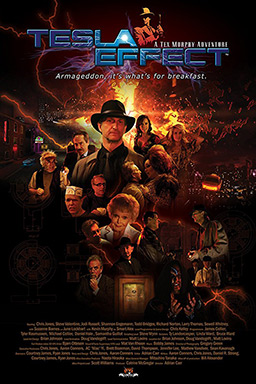
Nuon is a technology developed by VM Labs that adds features to a DVD player. In addition to viewing DVDs, one can play 3D video games and use enhanced DVD navigational tools such as zoom and smooth scanning of DVD playback. One could also play CDs while the Nuon graphics processor generates synchronized graphics on the screen. There were plans to provide Internet access capability in the next generation of Nuon-equipped DVD players.

Under a Killing Moon is a 1994 point-and-click adventure interactive movie video game. It is the third installment in the Tex Murphy series of adventure games produced by Access Software. In it, the detective Tex Murphy finds himself unwittingly involved in the affairs of a dangerous cult.

Tom Clancy's Splinter Cell: Pandora Tomorrow is a 2004 stealth game developed and published by Ubisoft Shanghai and Ubisoft Milan. The game is the sequel to Splinter Cell and the second game in the Splinter Cell series endorsed by writer Tom Clancy. It follows the covert activities of Sam Fisher, an agent working for a black-ops branch of the National Security Agency (NSA) called "Third Echelon". Michael Ironside returns to voice Sam Fisher, while Dennis Haysbert voices the character Irving Lambert, Fisher's boss, making this the only time he is not voiced by Don Jordan. Lalo Schifrin provides the theme music for the game.
An interactive film is a video game or other interactive media that has characteristics of a cinematic film. In the video game industry, the term refers to a movie game, a video game that presents its gameplay in a cinematic, scripted manner, often through the use of full-motion video of either animated or live-action footage.

Tex Murphy is a series of video games designed by Chris Jones. The eponymous main character is portrayed in live-action by Chris Jones himself. He is characterized as a down-on-his-luck private investigator in a post-nuclear future San Francisco, borrowing tropes from both the film noir and cyberpunk genres.

Access Software, Inc. was an American video game developer based in Salt Lake City, Utah. Founded in November 1982 by Bruce Carver and Chris Jones, the company created the Beach Head, Links and Tex Murphy series, as well as Raid over Moscow. Access Software was acquired by Microsoft in April 1999, transitioning in name twice before being acquired by Take-Two Interactive in October 2004, receiving the name Indie Built. In January 2005, Access Software became part of Take-Two's 2K label. Following a poor financial performance at Take-Two, Indie Built was closed down in May 2006.

The Pandora Directive is the fourth installment in the Tex Murphy series of graphic adventure games produced by Access Software. After its creators reacquired the rights to the series, it was re-released on Good Old Games in July 2009.
Christopher Jones is a video game designer and producer, CEO, finance professional, and actor. He is best known for a series of interactive movies in which he stars as Tex Murphy, a private investigator who lives in San Francisco in the middle of the 21st century.

Lego Creator is a sandbox game for Microsoft Windows, which involves building with virtual Lego elements. The game has no missions, objectives, challenges, or money constraints. The game was released on 11 November 1998.

Bookworm Adventures is a word-forming puzzle video game, the follow-up to Bookworm from PopCap Games. Released in November 2006, Bookworm Adventures combines the "create words from sets of letters" aspect of Bookworm with several elements of a role-playing video game. In the 2007 Interactive Achievement Awards, Bookworm Adventures won the "Downloadable Game of the Year". The game also won three Zeeby awards for Best Word & Trivia Game of 2006, Best Game Design of 2006 and Best Story/Narrative of 2006.

Mean Streets is a graphic adventure game developed and published by Access Software for MS-DOS in 1989 exclusively in North America. It was ported to the Commodore 64, Atari ST, and Amiga in 1989 and 1990 by The Code Monkeys. Atari ST and Amiga ports were only released in Europe. The game, set in a dystopian cyberpunk neo-noir world, is the first in the series of Tex Murphy mysteries; its immediate sequel is Martian Memorandum. In 1998, Mean Streets was remade as Tex Murphy: Overseer.
Big Finish Games is an American independent game developer formed by members of Access Software/Indie Built following the company's closure in 2007. The company was founded with the goal of developing story-driven, interactive games. The company's debut production, Three Cards to Midnight, was released on May 7, 2009.
Tron is an American science fiction media franchise created by Steven Lisberger and Bonnie MacBird. It began with the eponymous 1982 film produced by Walt Disney Pictures. The original film portrays Jeff Bridges as Kevin Flynn, a genius computer programmer and video game developer who becomes transported inside a digital virtual reality known as "The Grid", where he interacts with programs in his quest to escape.
An adventure game is a video game genre in which the player assumes the role of a protagonist in an interactive story, driven by exploration and/or puzzle-solving. The genre's focus on story allows it to draw heavily from other narrative-based media, such as literature and film, encompassing a wide variety of genres. Most adventure games are designed for a single player, since the emphasis on story and character makes multiplayer design difficult. Colossal Cave Adventure is identified by Rick Adams as the first such adventure game, first released in 1976, while other notable adventure game series include Zork, King's Quest, Monkey Island, Syberia, and Myst.

King's Quest: Mask of Eternity is a hybrid point-and-click adventure and action-adventure video game developed and published by Sierra Studios in 1998. It was the eighth official game in the King's Quest series, the first and only game in the main series where the main character is neither King Graham nor a member of his family, as well as the first in the series to use a full 3D engine as opposed to the 2D cartoon or pixel style of the earlier games and the first to omit the sequel numbering system on box artwork and title screen.

Tesla Effect: A Tex Murphy Adventure is the sixth game in the Tex Murphy series of detective adventure games, developed by Big Finish Games and published by Atlus. Like the previous three games, it tells much of its story through live-action full-motion video sequences, and features freely explorable 3D environments during gameplay.
Avatar is an American epic science fiction media franchise created by James Cameron, which began with the eponymous 2009 film. Produced by 20th Century Studios and distributed by Lightstorm Entertainment, it consists of associated merchandise, video games, and theme park attractions. Avatar is set in the mid-22nd century on Pandora, a lush habitable moon of a gas giant in the Alpha Centauri star system. The films' central conflict is between the indigenous Na'vi led by Jake Sully and Neytiri, and humans led by Colonel Miles Quaritch from the Resources Development Administration (RDA), a megacorp which has arrived on Pandora to colonize and pillage it for its natural resources. The title of the series refers to the genetically engineered Na'vi body operated from the brain that humans pilot to interact with on Pandora.
Borderlands is an action role-playing first-person looter shooter video game franchise in a space Western science fantasy setting, created and produced by Gearbox Software and published by 2K for multiple platforms.












